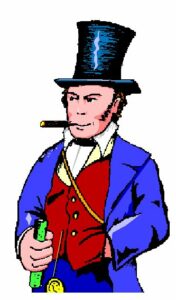 He has been described as one of the most ingenious and prolific figures in engineering history, one of the 19th-century engineering giants.
He has been described as one of the most ingenious and prolific figures in engineering history, one of the 19th-century engineering giants.
One of the greatest figures of the Industrial Revolution, a man who changed Victorian England with his designs and ingenious constructions, which we can still see today.
Brunel built dockyards, the Great Western Railway (GWR), a series of steamships including the first propeller-driven transatlantic steamship, and numerous important bridges and tunnels. His designs revolutionised public transport and modern engineering.
Though Brunel’s projects were not always successful, they often contained innovative solutions to long-standing engineering problems. During his career, Brunel achieved many engineering firsts, including:
- assisting in the building of the first tunnel under a navigable river (the River Thames).
- the development of the SS Great Britain, the first propeller-driven, ocean-going iron ship, which, when launched in 1843, was the largest ship ever built. In fact, his propellor design is still in use today.
- He designed the Monkwearmouth Docks in 1831.
- In 1844 he introduced a system of pneumatic propulsion on the South Devon Railway, but the experiment was a failure.
- In 1833 he was appointed chief engineer to the Great Western Railway.
- He introduced the broad-gauge railway (rails 2 metres [7 feet] apart) which started the famous “battle of the gauges.”
- He argued that a broad gauge made possible high speeds that resulted in a great stimulus to railway progress.
- He designed and built Paddington Station, which is still operating today.
- For the Crimean war he made a pre-fabricated hospital, in only six days, known as Renkioi hospital. Florence Nightingale was even heard to refer to them as ‘Those magnificent huts’.
 I K Brunel was an amazing man, but all this nearly didn’t happen as he was injured when working with his father on the Rotherhithe Tunnel, it collapsed on him, putting him in hospital. There he vowed never to work underground again!
I K Brunel was an amazing man, but all this nearly didn’t happen as he was injured when working with his father on the Rotherhithe Tunnel, it collapsed on him, putting him in hospital. There he vowed never to work underground again!
So, what do you think he did from his hospital bed? He learnt of a competition to design a bridge across a gorge near Bristol, he entered, he won it, and built what we now call the Clifton Suspension Bridge. This is the weird bit, it wasn’t completed until after his death. There were terrible funding problems which delayed it, but in the end, it was built and is a tribute to his genius.
The Musical
 If you want to meet I K Brunel our sister site, Educational Musicals, have published a musical for children, The Victorian Historian – A Journey to Victorian Britain, where two children accidentally get transported in a time machine to Victorian Britain, in their journey to return to the present they met the great Victorian engineer, Isambard Kingdom Brunel.
If you want to meet I K Brunel our sister site, Educational Musicals, have published a musical for children, The Victorian Historian – A Journey to Victorian Britain, where two children accidentally get transported in a time machine to Victorian Britain, in their journey to return to the present they met the great Victorian engineer, Isambard Kingdom Brunel.
You can download this 50-minute show by clicking on The Victorian Historian – A Journey to Victorian Britain supplied ready to perform by 15 to 100 children with script, (including stage directions) historical Fact Sheets, Art Pack showing how to make the scenery, costumes, and props along with 24 MP3 files, being both performance and rehearsal tracks.
Your children can enjoy being part of history.
Isn’t History Fun?
10 questions to discuss:
- What specific engineering challenges did Brunel overcome in building the Clifton Suspension Bridge, given his vow never to work underground again?
- Beyond the broad gauge, what other features of the Great Western Railway were considered innovative at the time?
- How did Brunel’s development of the SS Great Britain influence future ship design and transatlantic travel?
- Despite some failures like pneumatic propulsion, what were some other notable “firsts” achieved by Brunel during his career?
- Besides Paddington Station, are there any other structures designed by Brunel that are still in use today?
- What were the key arguments for and against the broad gauge system compared to the standard gauge?
- How did Brunel’s prefabricated hospital contribute to the Crimean War and what was Florence Nightingale’s response?
- What challenges did Brunel face in financing and constructing his various projects, and how did he overcome them?
- Was Brunel primarily motivated by profit, innovation, or something else entirely?
- How does Brunel’s legacy impact modern engineering and infrastructure projects?
For more information on this incredible man go to:
© Tony Dalton

